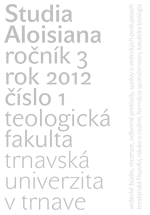NaProTechnology – nadzieją dla niepłodnych małżonków
NaProTechnology – a Hope for Infertile Couples
Author(s): Bożena BassaSubject(s): Social Sciences, Gender Studies, Health and medicine and law, Family and social welfare, Demography and human biology, Sociobiology
Published by: Teologická fakulta Trnavskej univerzity
Keywords: responsible parenthood; marital infertility; treatment of infertility; NaProTechnology;
Summary/Abstract: Parenthood is the main point of the marital community. At present, an important number of married couples are not capable of becoming parents for various reasons. Special mission of medicine is to assist the spouses undergoing difficulties in the accomplishment of their parental mission. One of the proposals offered by medicine are the current assisted reproductive technologies such as in vitro fertilisation. The technologies are of utilitarian and pragmatic character, undermining human dignity, impairing the unity of marriage and the child’s right to be conceived and born within a marriage. NaProTechnology is an alternative to this stream of practices and procedures of modern reproductive medicine. The founder of this new domain of medicine is professor Thomas Hilgers. NaProTechnology is a method of supporting human reproductivity. For treatment and diagnosis, NaProTechnology makes use of all the methods applied in classical medicine, which are frequently extender and improved. The so called Surgical NaProTechnology whose aim is to resituate the natural fertility, takes an important place in treatment of infertility. The therapeutic programme takes 18 to 24 months, in some cases up to 72 months. If the child is not conceived during this time, adoption is recommended to the spouses. Owing to its in-depth diagnosis and multidimensional treatment, NaProTechnology reveals high efficiency in treatment of infertility – its average efficiency, regardless of the cause of infertility and the age of the spouses, is about 50 %, for certain groups of patients its efficiency goes up even to 80 %.
Journal: Studia Aloisiana
- Issue Year: 3/2012
- Issue No: 1
- Page Range: 61-70
- Page Count: 10
- Language: Polish

